Postpartum hair loss is a normal occurrence, and one that goes away with time. However, you can use these tips to reduce its impact.
Your baby has completed a quarter of her first year of life and things are slowly beginning to settle down. You’ve got the knack of breastfeeding by now, baby is feeding and sleeping on some sort of schedule, and you are beginning to feel a little bit like your old self. That’s when you’re hit in the gut with a new problem – postpartum hair loss!
This can really seem like a bolt from the blue, and its probably not what you were expecting at this stage of your motherhood journey. Your hair seemed to have improved during pregnancy – why is it falling so much now? You notice it because it’s more than the usual loss of a few strands – this time the pillow and your drain are telling a rather scary story!

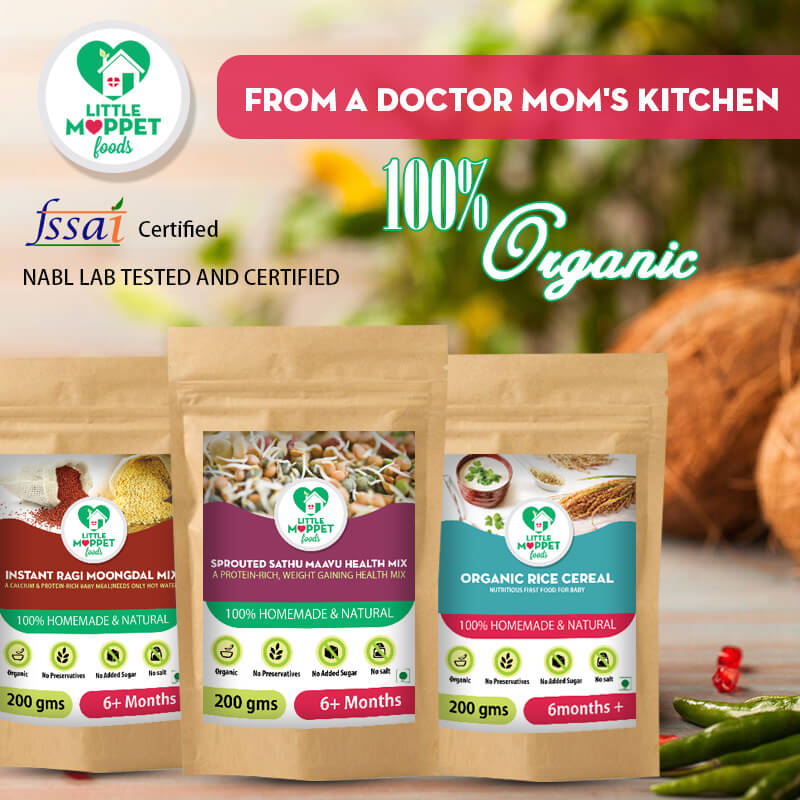
But don’t worry – this hair loss is perfectly normal. Some Moms worry that it’s because of the stress of taking care of a newborn – but it isn’t; it’s just a part of your body getting back to its pre-pregnancy state. And there’s one reason for this – hormones!
What causes postpartum hair loss?
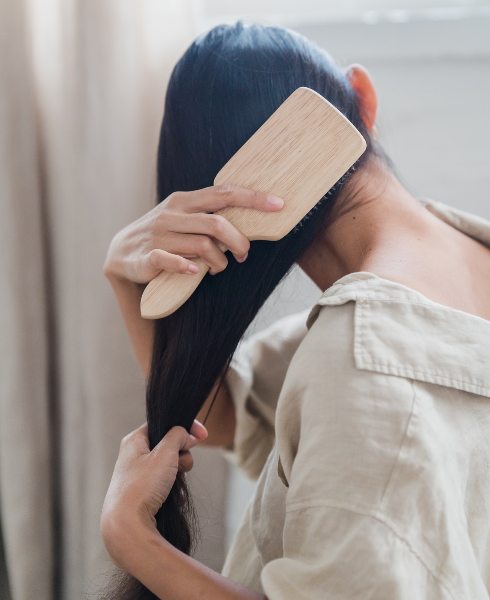
As they say, a known enemy is better than an unknown friend, so let’s begin by trying to understand the cause of postpartum hair loss. For this, we first need to know a little about the cycles of hair growth.
Your hair grows in cycles of three phases – growing phase, resting phase and shedding phase – which repeat over and over again. Here’s what each phase means.
Growing phase or Anagen phase – This is the phase where the hair actually grows longer
Resting phase or Catagen phase – Here, the hair growth slows down, and the hair follicle gets smaller.
Shedding phase or Telogen phase – During this phase, the hair begins to fall out.
The cycle repeats again with the anagen phase, where new hairs grow to replace the ones that fell out in the telogen phase. All the hair strands on your head are in various phases at any given time. Over 85% of the hair is in the anagen phase, and stays there for 2-4 years. The resting phase lasts for 2-4 months, after which hair starts falling out. It is estimated that the average human loses around 100 hairs a day.
Pregnancy affects the normal hair cycle. Pregnancy causes an increase in the levels of hormones like estrogen, which keep the hair in the growing phase for longer. As a result, the shedding phase is delayed, and you’ll notice your hair feels thicker.
After childbirth however, the levels of estrogen start to drop, and reach pre-pregnancy levels by around 3 months. This puts your hair back in its regular cycle of growing-resting-shedding. However, since most of your hair was in the growing phase for longer than usual, you’ll naturally have more hair reaching the shedding phase than you usually do. That’s why postpartum hair loss is also called telogen effluvium, which means ‘excessive shedding’. Instead of the usual 100, you may lose up to 300 hairs a day – which explains why it feels like a lot!
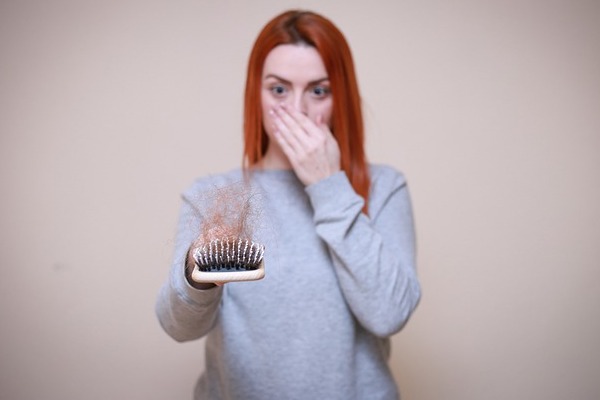
Postpartum hair loss may be from any part of the head, usually when you shower or brush your hair. Some women may find that they lose more hair in the front, making it look like their hairline is receding. Breastfeeding mothers may notice a less drastic loss of hair, which may change as they start weaning.
However, this is not a permanent problem – most postpartum hair loss is resolved by the time the baby turns one. Your hair length may remain uneven for a while as the new hairs take some time to come in and grow. If you have a family history of baldness or hair thinning, you may experience more severe hair loss with each pregnancy.
Can you prevent postpartum hair loss? Well, no. As explained above, postpartum hair loss is just a way of the body resetting itself to its pre-pregnancy state. There are currently no treatments to stop it, but if all that hair fall is breaking your heart, there are a few things you can do to deal with this temporary issue and ensure that the new hair that comes in is nice and healthy!
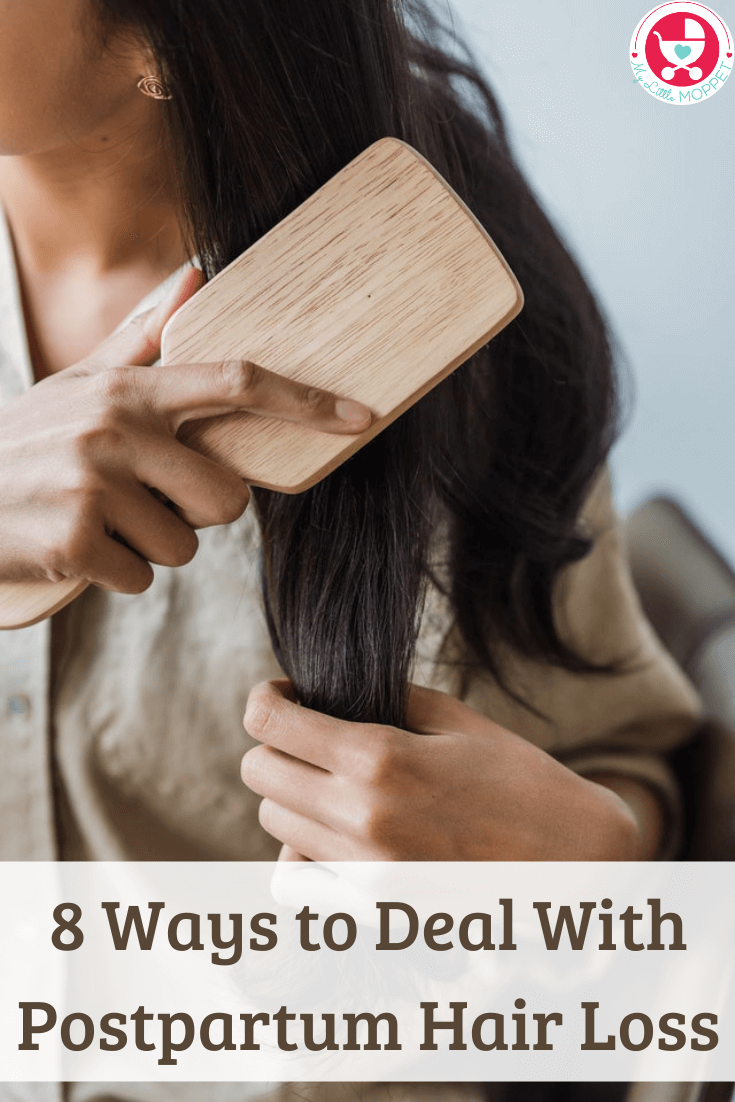
1. Eat a nutrient-rich diet.
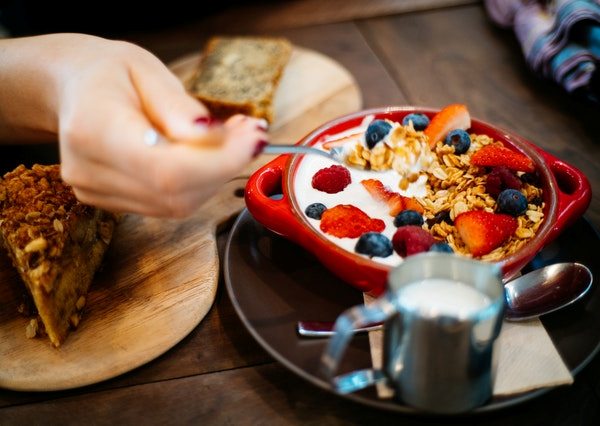
Your body has just delivered a baby, which means it has just accomplished something incredible! There is a great deal of recovery happening in the months following childbirth, and a healthy diet can help in this while also helping control postpartum hair loss.
A good diet rich in vital nutrients can speed up the growing of hair after the shedding phase. One of the most important nutrients to focus on is protein. Hair is basically made up of a kind of protein, and a protein-rich diet can strengthen hair and promote cell repair. Antioxidant-rich foods are also helpful as they protect the hair follicles from damage.
Here is a list of foods to include in your diet to control postpartum hair loss:
- Animal protein like chicken, lean meat, eggs
- Fish like tuna, salmon, mackerel, sardines
- Dairy products like milk, yogurt, cheese
- Pulses like chickpeas, kidney beans, lentils
- Vegetables like spinach, broccoli, sweet potato, cauliflower, mushrooms, carrots
- Fruits like avocado, berries, bananas, papaya, mango, oranges, pineapple
- Dried fruits like apricots, prunes, raisins
- Nuts like peanuts, pistachio, cashew nuts, almonds, walnuts
- Whole grains like brown rice, oats, whole wheat flour
2. Take your supplements.
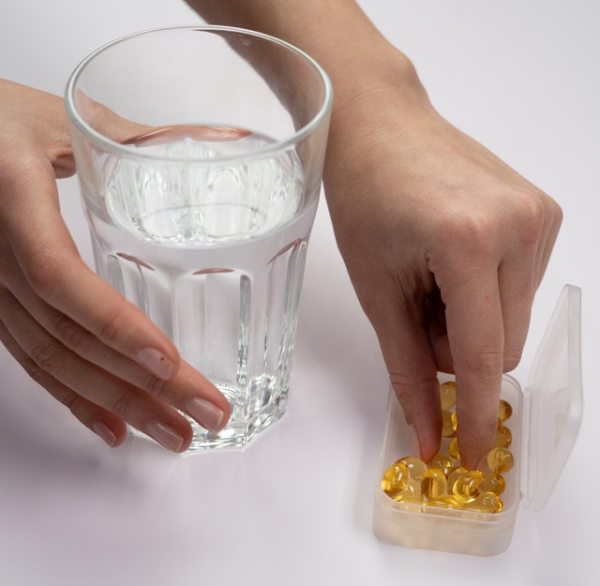
You probably had some antenatal supplements prescribed by your doctor, and you’ve either been told to continue with them or have new ones to consume now. These should be taken in addition to a healthy diet, since they’ll speed up the body’s recovery including resetting the hair growth cycle. There are many important vitamins and minerals that are important in the postpartum stage, especially if you are breastfeeding since some of the nutrients in your body pass through the breast milk.
Here are the nutrients to be included in your postpartum supplements, as per the recommendation of the The American Pregnancy Association:
- Vitamin A – Essential for cellular growth and produces natural oils in the scalp that promote hair growth
- Vitamin B2 (riboflavin) – Important part of enzymes that help in the growth of hair cells
- Vitamin B7 (biotin) – Stimulates keratin production and boosts follicle growth
- Vitamin B9 (folate) – Required for cell division of cells in skin, hair and nails
- Vitamin B12 – Supplies follicles and hair cells with blood, hence stimulating growth of new hair
- Vitamin C – Produces collagen, an important protein for hair
- Vitamin D – Stimulates hair follicles and increases absorption of calcium
- Vitamin E – Provides antioxidant action to fight free radical damage that may block hair growth
- Iron – Produces hemoglobin, that supplies oxygen to hair cells and prevents anemia
- Zinc – Boosts the function of the oil glands on the scalp that stimulates the follicles
- Selenium – Essential for the synthesis of various hormones and proteins that affect the growth of new hair
3. Be gentle with styling.
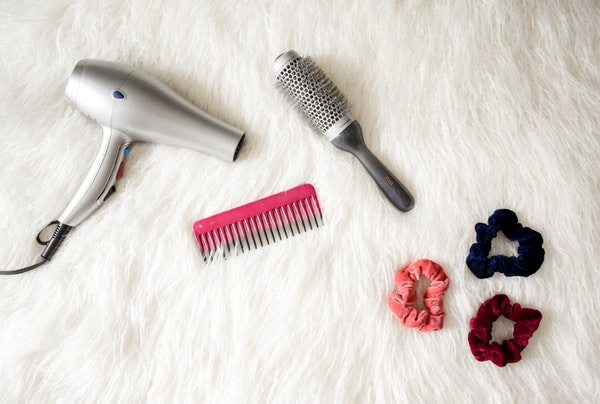
When you’ve got a little baby to look after along with other responsibilities, it’s tempting to pull your hair back in a tight bun or pony tail and just secure it in place with a rubber band. However, while this may seem convenient in the moment, it can cause damage in the long run.
Similarly, using heat styling on hair that’s already lost volume can make it look thinner. While your hair is resetting its growth cycle, stay away from hair dryers, curling irons and hair straighteners. Let your hair air dry and use a soft microfiber towel to dry it to reduce friction between strands.
Hold on to your coloring or perming sessions till the shedding phase is over. Brushing your hair once or twice a day is also a god idea, as long as you don’t overdo it. Avoid combs with sharp teeth and use a soft bristled brush instead. If tying hair, use satin scrunchies or large barrettes and don’t tie it too tight. You can also use headbands and scarves to hide thinning hair and still look stylish.
4. Use the right products.
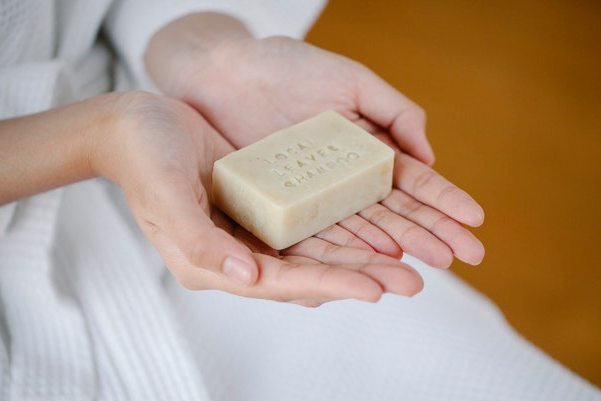
You don’t have to stay away from washing your hair while going through postpartum hair loss, you just need to do it right. Don’t wash hair everyday – stick to once or twice a week based on your hair type.
The products you use are of the utmost importance as you want them to be as gentle as possible. When choosing a shampoo, choose a volumizing formula to add body. Read the ingredients label and make sure to choose a product that is free from parabens, silicones, SLS and SLES. Avoid shampoos that are labeled ‘conditioning’ as they can weigh your hair down.
When buying a conditioner, choose one that doesn’t have ‘intense conditioning’ mentioned on it. Apply conditioner only to the ends of hair and not to the scalp.
5. Change your hairstyle.

This is one of the easiest ways to deal with thinning hair. Many new Moms prefer the convenience of short hair, especially if it’s a wash-and-go hairstyle. Short hair also makes thin hair look fuller. You can ask your stylist for a cut that creates layers that add volume.
Many women lose hair on the front of their heads and this causes a great deal of stress. It can also look awkward when the new hairs are growing in after the shedding phase. One way to manage this is to cut bangs or fringes that’ll hide the thinning in the front and accommodate the growing hairs as well.
Another small thing that can have a big impact is changing your part. If your hair is thinning long the part of your hair, move it to the opposite side for a different look as well as to hide the hair loss.
6. Get an oil massage.
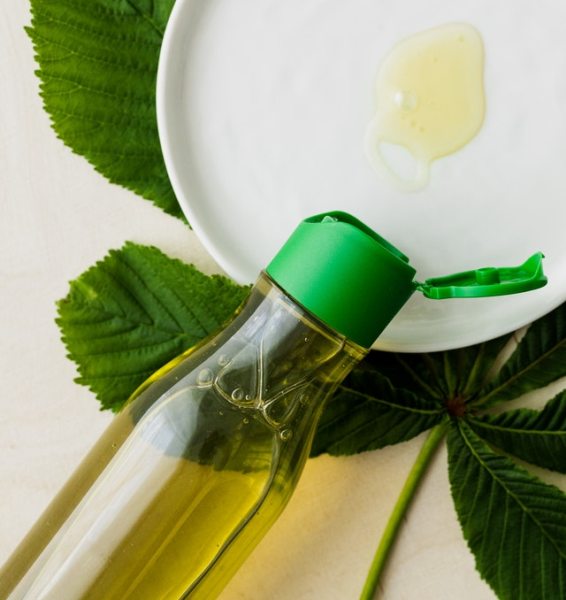
A massage is something every new Mom enjoys but a head massage works well for postpartum hair loss. Gentle massage on the scalp improves blood circulation to the scalp that stimulates the follicles and promotes hair growth. Massage using only the finger tips and not the nails to avoid damaging the skin on the scalp.
While a head massage on its own is beneficial, using an oil makes the process smoother and also transfers the benefits of the oil to the scalp. Coconut oil, castor oil, almond oil and olive oil are good options for an oil massage to tackle postpartum hair loss. Warm the oil a little before the massage to increase penetration of the oil in the scalp and wrap your head in a hot damp towel for 30 minutes.
7. Try a natural hair pack.
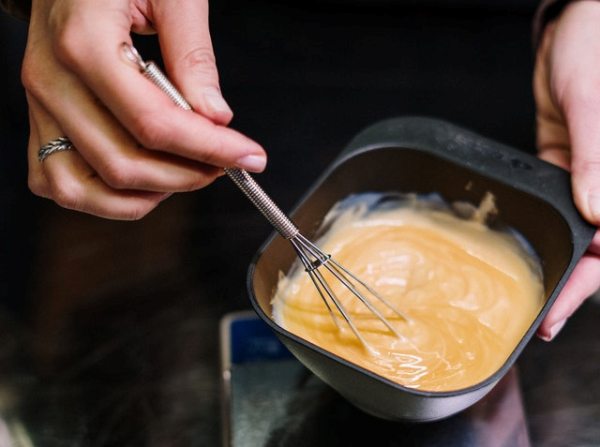
Just like an oil massage, a hair pack made with natural ingredients from the kitchen can also help promote healthy hair growth. There are many hair packs you can create right at home with little effort and time.
- Fenugreek – Soak some fenugreek seeds overnight. Strain the soaking water and apply it to the scalp. Leave for 2 hours and wash off.
- Curd – Apply plain, un-sweeteened curd or yogurt to the scalp and hair shaft. Leave on for 15 minutes and wash off.
- Eggs – Mix two egg whites with olive oil and apply over the scalp. Leave for 30 minutes and wash off.
- Avocado – Mix the flesh of a ripe avocado with a tablespoon of coconut milk. Apply on the scalp and leave to dry.
- Bhringraj – Grind a handful of bhringraj leaves to a paste. Apply to the hair. Let it dry and wash off.
Remember to use shampoo to wash off the pack so you’re not left with any residue.
8. Reduce stress and sleep well.
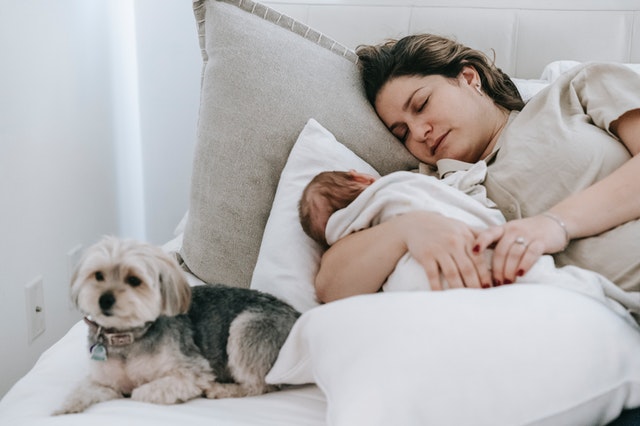
While good sleep does not directly affect postpartum hair loss, it does prevent further loss of hair once the shedding phase is over. The quality and duration of your sleep has a significant impact on your hair, due to the hormone melatonin.
Melatonin regulates the sleep cycle and it is also related to hair growth. When your sleep is affected, your body’s melatonin levels decrease leading to more hair fall- the last thing you want when you’re already struggling with postpartum hair loss!
Stress also has a similar effect on hair fall, so it is important to regulate that as well. Try to take short naps whenever you can manage them. Meditate or do breathing exercises to calm your nerves and to deal with any anxiety. Get help for chores adn errands so you are not overworked and stressed.
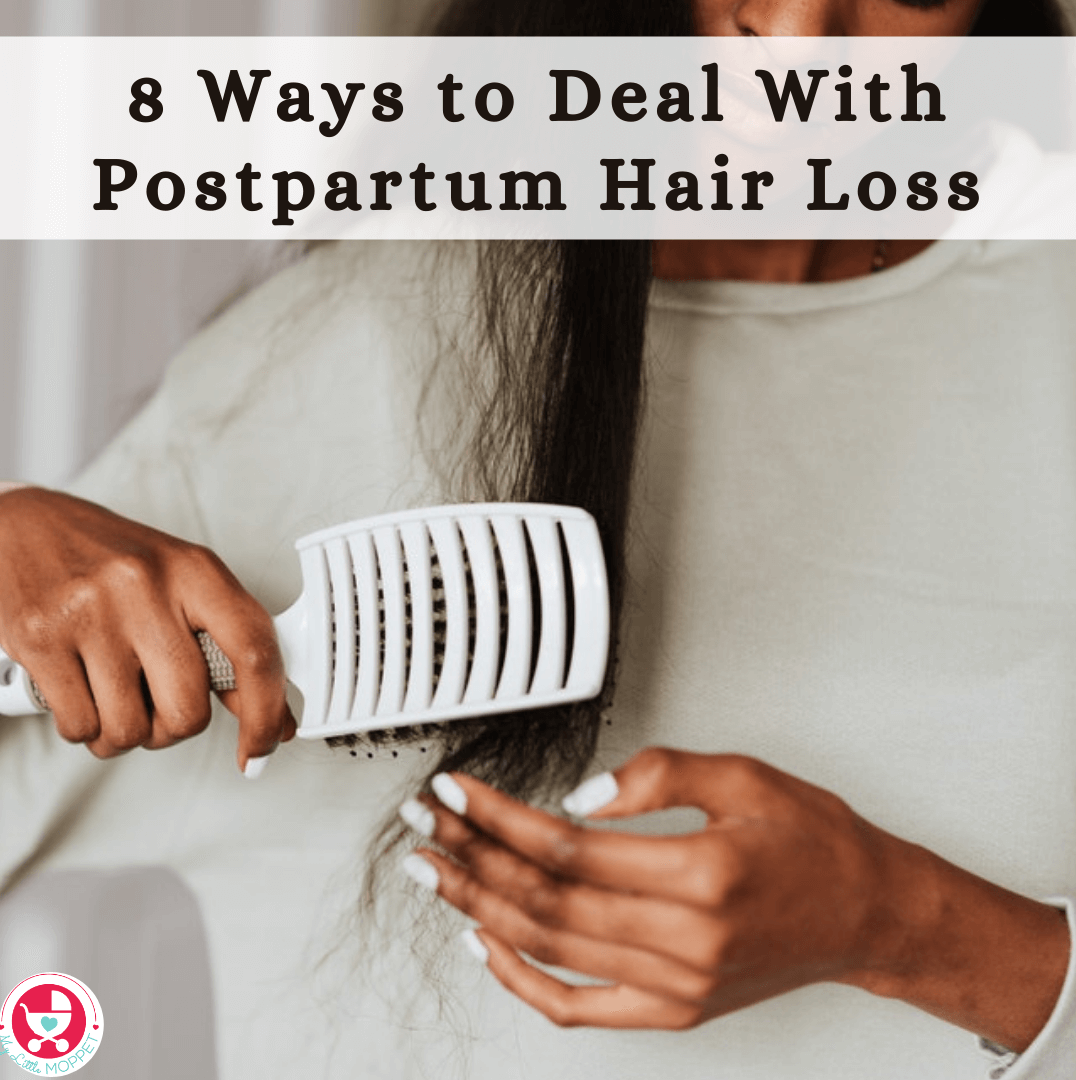
When suffering from postpartum hair loss, it’s common to see strands of hair all over your home. However, this is more than an annoyance – it can also be dangerous when the hair forms a hair tourniquet on your baby’s body. This is when a strand of hair wraps around a part of the baby’s body like a toe or finger so tightly that it cuts off blood circulation to that body part. Avoid this by disposing off any stray hairs that you see and by vacuuming your space regularly.
If your hair still seems to be falling even after your baby’s first birthday, it may help to see a dermatologist or a trichologist. Hair fall can be due to many other reasons like anemia or postpartum thyroiditis, an inflammation of the thyroid gland. Your doctor will be able to determine the exact cause for your hair loss and prescribe appropriate treatment.
Buy Healthy Nutritious Baby, Toddler food made by our own Doctor Mom !
Shop now!
